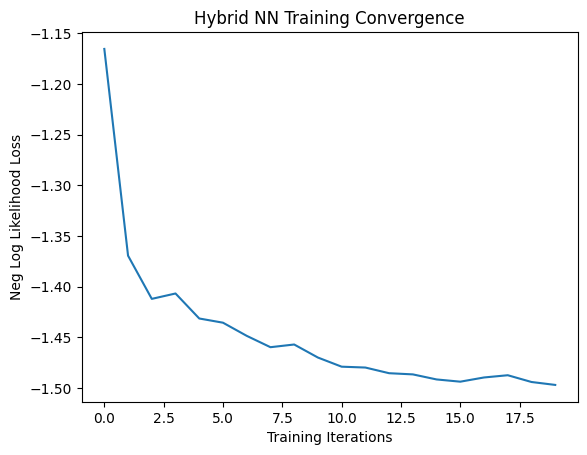Hybrid Quantum Neural Networks¶
The example below highlights a hybrid quantum neural network workflow with CUDA Quantum and Pytorch where both layers are GPU accelerated to maximise performance.

We perform binary classification on the MNIST dataset where data flows through the neural network architecture to the quantum circuit whose output is used to classify hand written digits.
[1]:
%pip install matplotlib torch torchvision
[2]:
# Import the relevant packages
import numpy as np
import matplotlib.pyplot as plt
import torch
from torch.autograd import Function
from torchvision import datasets, transforms
import torch.optim as optim
import torch.nn as nn
import torch.nn.functional as F
import cudaq
from cudaq import spin
[3]:
# GPU utilities
cudaq.set_target("nvidia") # Set CUDAQ to run on GPU's
torch.cuda.is_available(
) # If this is True then the NVIDIA drivers are correctly installed
torch.cuda.device_count() # Counts the number of GPU's available
torch.cuda.current_device()
torch.cuda.get_device_name(0)
device = torch.device("cuda:0" if torch.cuda.is_available() else "cpu")
[4]:
# Training set.
sample_count = 140
X_train = datasets.MNIST(
root="./data",
train=True,
download=True,
transform=transforms.Compose([transforms.ToTensor()]),
)
# Leaving only labels 0 and 1.
idx = np.append(
np.where(X_train.targets == 0)[0][:sample_count],
np.where(X_train.targets == 1)[0][:sample_count],
)
X_train.data = X_train.data[idx]
X_train.targets = X_train.targets[idx]
train_loader = torch.utils.data.DataLoader(X_train, batch_size=1, shuffle=True)
# Test set.
sample_count = 70
X_test = datasets.MNIST(
root="./data",
train=False,
download=True,
transform=transforms.Compose([transforms.ToTensor()]),
)
idx = np.append(
np.where(X_test.targets == 0)[0][:sample_count],
np.where(X_test.targets == 1)[0][:sample_count],
)
X_test.data = X_test.data[idx]
X_test.targets = X_test.targets[idx]
test_loader = torch.utils.data.DataLoader(X_test, batch_size=1, shuffle=True)
Downloading http://yann.lecun.com/exdb/mnist/train-images-idx3-ubyte.gz
Downloading http://yann.lecun.com/exdb/mnist/train-images-idx3-ubyte.gz to ./data/MNIST/raw/train-images-idx3-ubyte.gz
100%|██████████| 9912422/9912422 [00:00<00:00, 72148113.67it/s]
Extracting ./data/MNIST/raw/train-images-idx3-ubyte.gz to ./data/MNIST/raw
Downloading http://yann.lecun.com/exdb/mnist/train-labels-idx1-ubyte.gz
Downloading http://yann.lecun.com/exdb/mnist/train-labels-idx1-ubyte.gz to ./data/MNIST/raw/train-labels-idx1-ubyte.gz
100%|██████████| 28881/28881 [00:00<00:00, 79537553.40it/s]
Extracting ./data/MNIST/raw/train-labels-idx1-ubyte.gz to ./data/MNIST/raw
Downloading http://yann.lecun.com/exdb/mnist/t10k-images-idx3-ubyte.gz
Downloading http://yann.lecun.com/exdb/mnist/t10k-images-idx3-ubyte.gz to ./data/MNIST/raw/t10k-images-idx3-ubyte.gz
100%|██████████| 1648877/1648877 [00:00<00:00, 45882038.30it/s]
Extracting ./data/MNIST/raw/t10k-images-idx3-ubyte.gz to ./data/MNIST/raw
Downloading http://yann.lecun.com/exdb/mnist/t10k-labels-idx1-ubyte.gz
Downloading http://yann.lecun.com/exdb/mnist/t10k-labels-idx1-ubyte.gz to ./data/MNIST/raw/t10k-labels-idx1-ubyte.gz
100%|██████████| 4542/4542 [00:00<00:00, 15252625.11it/s]
Extracting ./data/MNIST/raw/t10k-labels-idx1-ubyte.gz to ./data/MNIST/raw
[5]:
class QuantumFunction(Function):
"""This class defines the quantum circuit structure, the forward and the backward method."""
def __init__(self, qubit_count: int, hamiltonian: cudaq.SpinOperator):
"""Define the quantum circuit in CUDA Quantum"""
kernel, thetas = cudaq.make_kernel(list)
self.kernel = kernel
self.theta = thetas
self.hamiltonian = hamiltonian
qubits = kernel.qalloc(qubit_count)
self.kernel.h(qubits)
# Variational gate parameters which are optimised during training.
kernel.ry(thetas[0], qubits[0])
kernel.rx(thetas[1], qubits[0])
def run(self, thetas: torch.tensor) -> torch.tensor:
"""Excetute the quantum circuit to output an expectation value"""
expectation = torch.tensor(cudaq.observe(self.kernel, spin.z(0),
thetas.tolist()).expectation(),
device=device)
return expectation
[6]:
class QuantumFunction(Function):
"""Allows the quantum circuit to pass data through it and compute the gradients"""
@staticmethod
def forward(ctx, thetas: torch.tensor, quantum_circuit,
shift) -> torch.tensor:
# Save shift and quantum_circuit in context to use in backward.
ctx.shift = shift
ctx.quantum_circuit = quantum_circuit
# Calculate expectation value.
expectation = ctx.quantum_circuit.run(thetas)
ctx.save_for_backward(thetas, expectation)
return expectation
@staticmethod
def backward(ctx, grad_output):
"""Backward pass computation via finite difference parameter shift"""
thetas, expectation = ctx.saved_tensors
gradients = torch.zeros(len(thetas), device=device)
for i in range(len(thetas)):
shift_right = torch.clone(thetas)
shift_right[i] += ctx.shift
shift_left = torch.clone(thetas)
shift_left[i] -= ctx.shift
expectation_right = ctx.quantum_circuit.run(shift_right)
expectation_left = ctx.quantum_circuit.run(shift_left)
gradients[i] = (expectation_right -
expectation_left) / 2 * ctx.shift
return gradients * grad_output.float(), None, None
[7]:
class QuantumLayer(nn.Module):
"""Encapsulates a quantum circuit and a quantum function into a quantum layer"""
def __init__(self, qubit_count: int, hamiltonian, shift: torch.tensor):
super(QuantumLayer, self).__init__()
# 1 qubit quantum circuit.
self.quantum_circuit = QuantumFunction(qubit_count, hamiltonian)
self.shift = shift
def forward(self, input):
ans = QuantumFunction.apply(input, self.quantum_circuit, self.shift)
return ans
[8]:
qubit_count = 1
hamiltonian = spin.z(0)
shift = torch.tensor(np.pi / 2)
class Net(nn.Module):
def __init__(self):
super(Net, self).__init__()
# Neural network structure.
self.conv1 = nn.Conv2d(1, 6, kernel_size=5)
self.conv2 = nn.Conv2d(6, 16, kernel_size=5)
self.dropout = nn.Dropout2d()
self.fc1 = nn.Linear(256, 64)
self.fc2 = nn.Linear(
64, 2
) # Output a 2D tensor since we have 2 variational parameters in our quantum circuit.
self.hybrid = QuantumLayer(
qubit_count, hamiltonian, shift
) # Input is the magnitude of the parameter shifts to calculate gradients.
def forward(self, x):
x = F.relu(self.conv1(x))
x = F.max_pool2d(x, 2)
x = F.relu(self.conv2(x))
x = F.max_pool2d(x, 2)
x = self.dropout(x)
x = x.view(1, -1)
x = F.relu(self.fc1(x))
x = self.fc2(x).reshape(
-1
) # Reshapes required to satisfy input dimensions to CUDA Quantum.
x = self.hybrid(x).reshape(-1)
return torch.cat((x, 1 - x), -1).unsqueeze(0)
[9]:
# We move our model to the CUDA device to minimise data transfer between GPU and CPU.
model = Net().to(device)
optimizer = optim.Adam(model.parameters(), lr=0.001)
loss_func = nn.NLLLoss().to(device)
epochs = 20
epoch_loss = []
model.train()
for epoch in range(epochs):
batch_loss = 0.0
for batch_idx, (data, target) in enumerate(train_loader): # Batch training.
optimizer.zero_grad()
data, target = data.to(device), target.to(device)
# Forward pass.
output = model(data).to(device)
# Calculating loss.
loss = loss_func(output, target).to(device)
# Backward pass.
loss.backward()
# Optimize the weights.
optimizer.step()
batch_loss += loss.item()
epoch_loss.append(batch_loss / batch_idx)
print("Training [{:.0f}%]\tLoss: {:.4f}".format(
100.0 * (epoch + 1) / epochs, epoch_loss[-1]))
Training [5%] Loss: -1.1656
Training [10%] Loss: -1.3695
Training [15%] Loss: -1.4121
Training [20%] Loss: -1.4068
Training [25%] Loss: -1.4315
Training [30%] Loss: -1.4356
Training [35%] Loss: -1.4486
Training [40%] Loss: -1.4598
Training [45%] Loss: -1.4571
Training [50%] Loss: -1.4700
Training [55%] Loss: -1.4790
Training [60%] Loss: -1.4798
Training [65%] Loss: -1.4854
Training [70%] Loss: -1.4866
Training [75%] Loss: -1.4916
Training [80%] Loss: -1.4938
Training [85%] Loss: -1.4896
Training [90%] Loss: -1.4874
Training [95%] Loss: -1.4941
Training [100%] Loss: -1.4970
[10]:
plt.plot(epoch_loss)
plt.title("Hybrid NN Training Convergence")
plt.xlabel("Training Iterations")
plt.ylabel("Neg Log Likelihood Loss")
[10]:
Text(0, 0.5, 'Neg Log Likelihood Loss')

[11]:
# Testing on the test set.
model.eval()
with torch.no_grad():
correct = 0
for batch_idx, (data, target) in enumerate(test_loader):
data, target = data.to(device), target.to(device)
output = model(data).to(device)
pred = output.argmax(dim=1, keepdim=True)
correct += pred.eq(target.view_as(pred)).sum().item()
loss = loss_func(output, target)
epoch_loss.append(loss.item())
print("Performance on test data:\n\tAccuracy: {:.1f}%".format(
correct / len(test_loader) * 100))